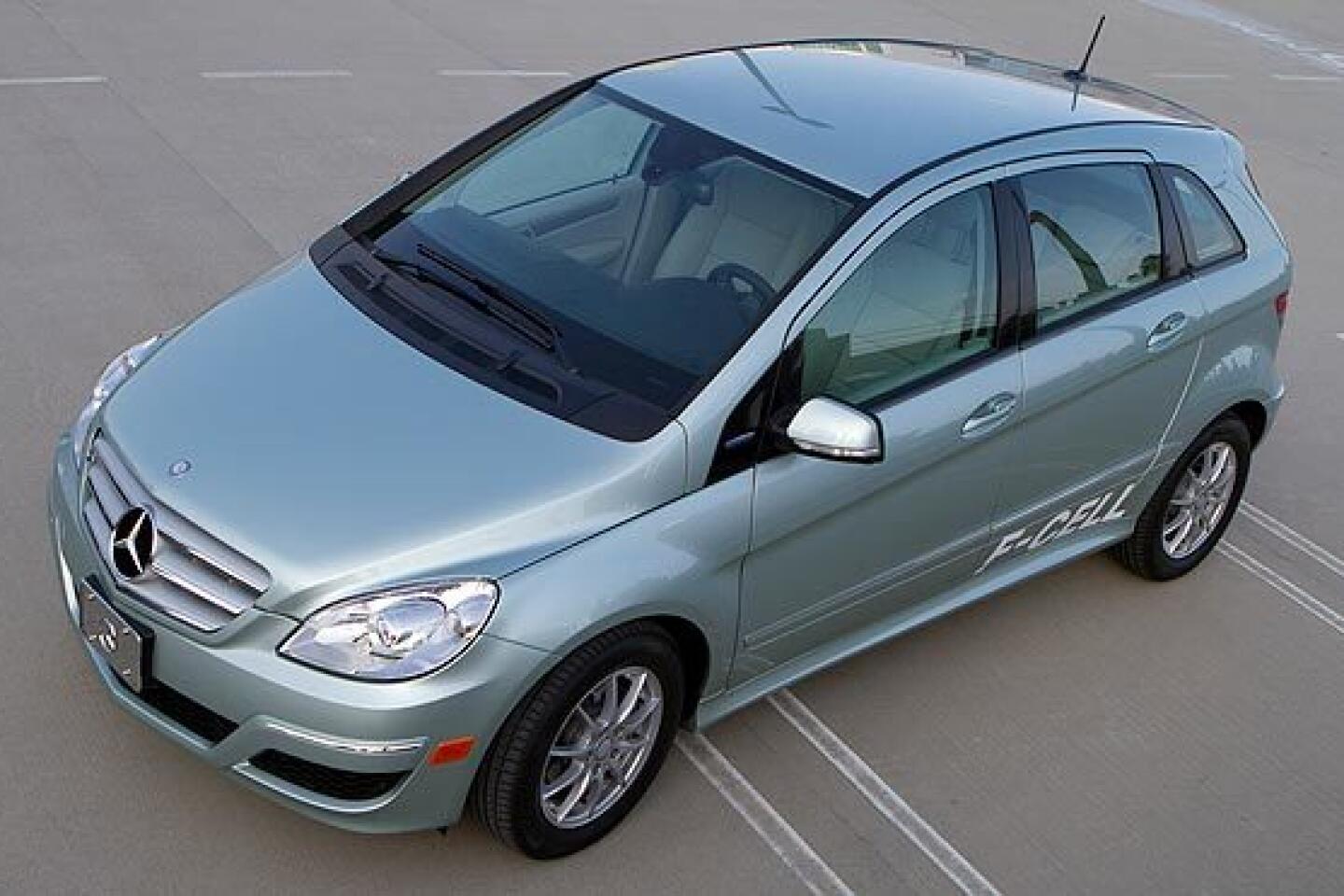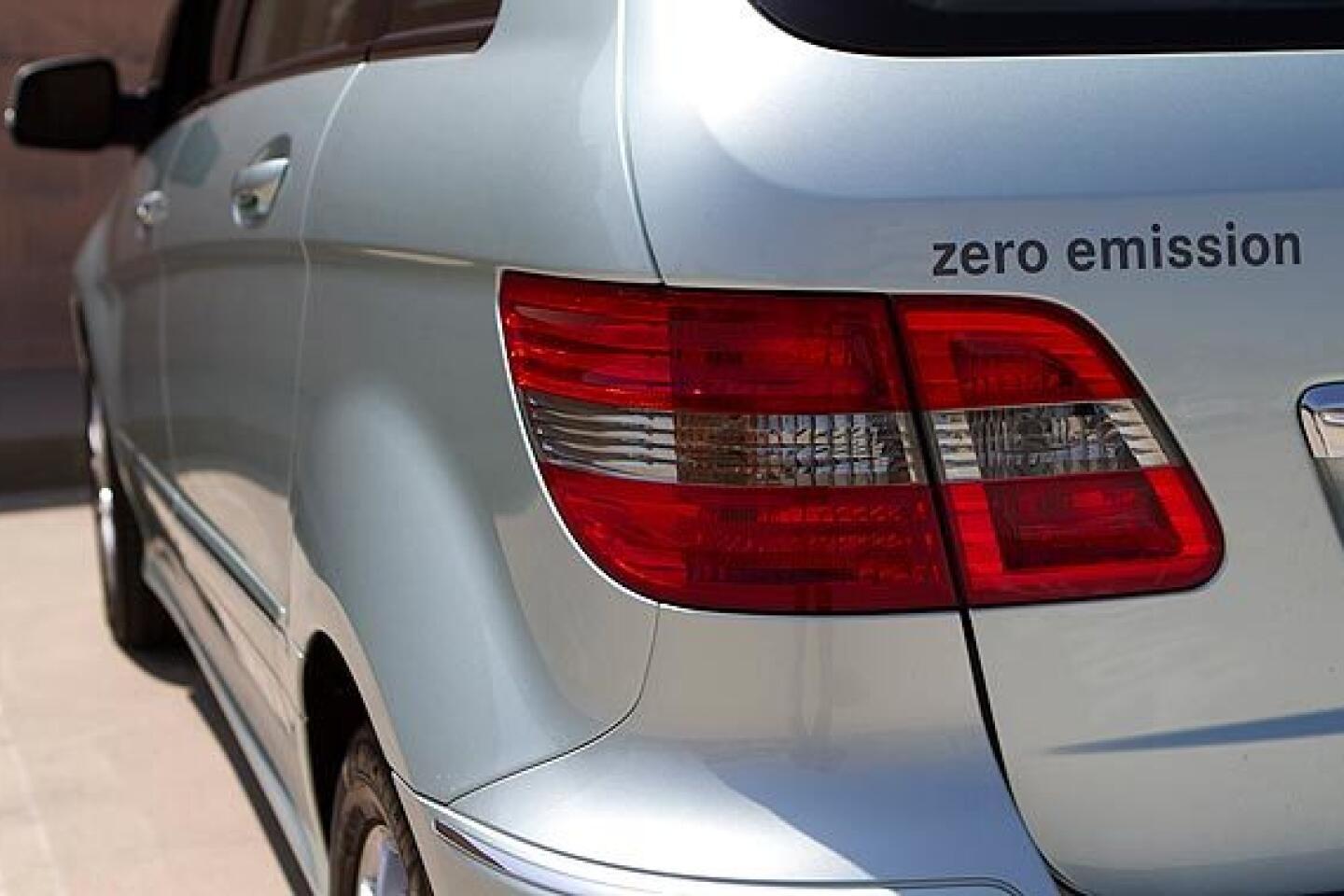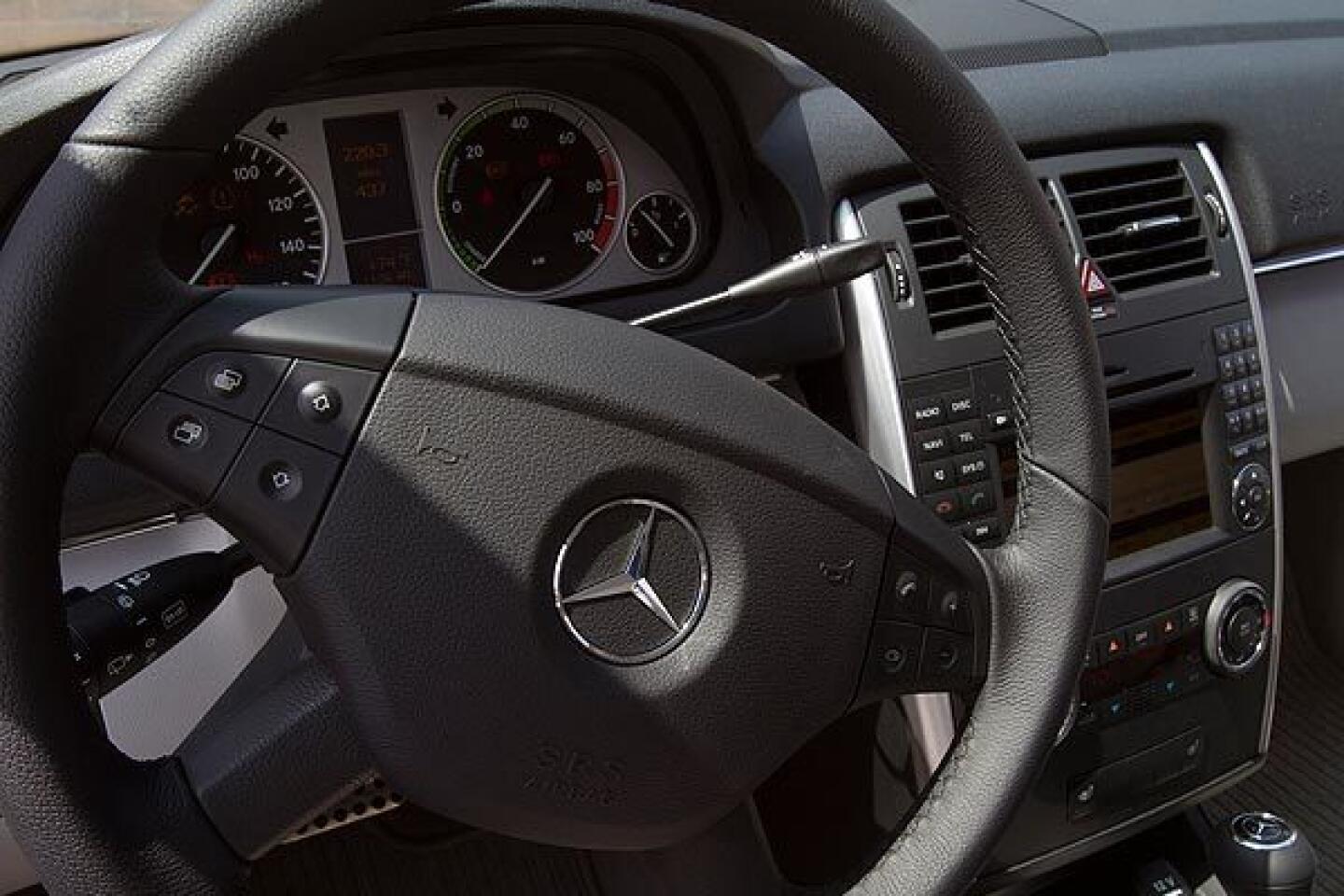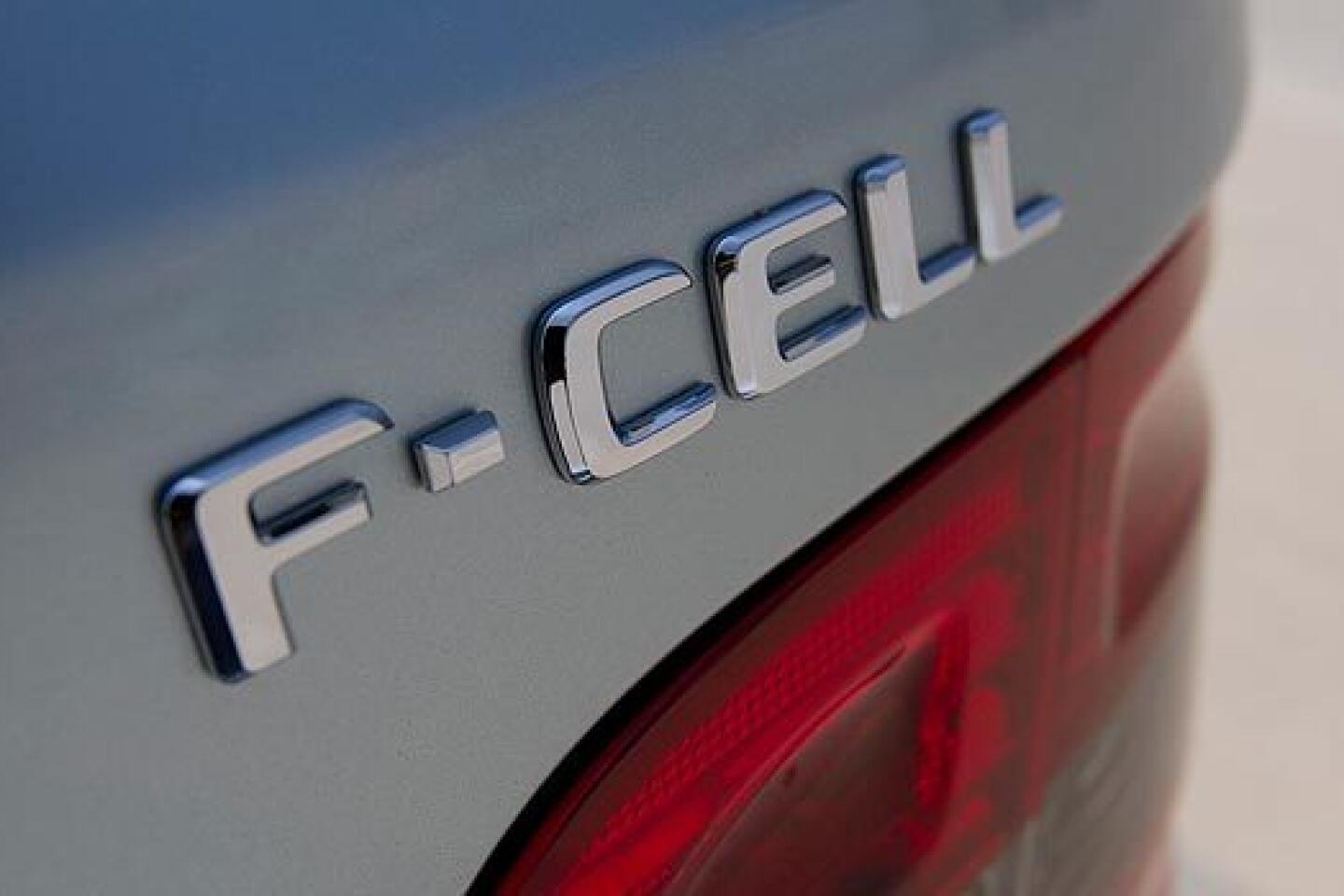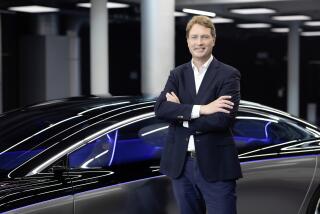With B-Class F-Cell, Mercedes rolls out an impressive steppingstone
- Share via
The only Mercedes hatchback on the U.S. market, the 2011 B-Class F-Cell, wouldn’t be recognizable as a Benz if it weren’t for its premium badge.
Its small, pragmatic silhouette is more Japanese than German. But the B-Class F-Cell is more notable for what’s under the hood than its profile.
The four-door subcompact is a hydrogen-powered electric vehicle that can travel more than 200 miles between fill-ups and doesn’t need an outlet to recharge.
The first Mercedes-Benz fuel-cell vehicle to be offered to the public, the B-Class F-Cell is available in one U.S. market: Los Angeles. Southern California is the only region in the country that currently has more than one hydrogen fueling station.
Right now, we have five. An additional 13 have been funded and will be built by the end of 2012. Just two of the current stations pump hydrogen gas with enough pressure to completely fill the tank on the F-Cell.
One’s on the UC Irvine campus. The other is in Culver City in a gated-off area that requires a pass code from Mercedes. It’s a sad state of affairs for what many hope will be the carbon-free automotive technology of the future.
By 2015, most of the major automakers — General Motors Co., Honda Motor Co. and Toyota Motor Corp. among them — have said they will go into volume production of hydrogen fuel-cell vehicles.
Early versions of many of those vehicles have been accessible to the public only in small pilot programs. Since 2008, the Honda FCX Clarity has been leased to a handful of SoCal customers. General Motors’ fuel-cell version of its Equinox is available for two- to three-month loans through its Project Driveway program.
The B-Class F-Cell is no different. Mercedes will build just 200 of the cars this year and is offering them lease-only in select global markets, including Norway, Germany and Japan. About 50 have rolled off the production line. Three Angelenos have them; 17 more have them on order and will receive their cars by the end of May.
At first glance, the two-year, $849-a-month lease price seems steep enough to send eco-minded customers to their nearest Prius dealer. On closer consideration, it’s fairly reasonable. Insurance, maintenance and all the 700-bar hydrogen fuel (bar is a unit of pressure) a driver can stuff into its reinforced, high-pressure tank are included in the lease price.
At its core, the car is a test vehicle for Mercedes — one that will be used as a steppingstone for its next-generation B-Class F-Cell, which will go into production in 2014.
For a steppingstone, it’s extremely impressive — both aesthetically and technologically. Its interior is finished with “alpaca grey” leather seats, navigation and other baseline luxury appointments.
The exterior is an understated metallic green that wouldn’t be obvious as an alternative-drivetrain vehicle if not for the text on its flanks and backside announcing its status as a “zero emission,” “F-Cell,” “hydrogen electric vehicle.”
The F-Cell is shorthand for fuel cell. That is to say, it’s a car that runs on electrochemical cells that convert energy from a chemical, such as hydrogen, into electricity. In other words, it’s an electric vehicle that runs on hydrogen gas.
Unlike plug-in electric vehicles such as the Nissan Leaf or Chevy Volt, which get their electricity from an external source — a power outlet — the F-Cell is propelled by electricity that is generated inside the vehicle.
This is how it works: Hydrogen gas is run through a platinum-coated, proton-conducting membrane that generates electricity by turning the gas into water. That electricity powers a 100-kilowatt AC induction electric motor that propels this front-wheel-drive car. The leftover water exits the drivetrain through the tailpipe and is practically unnoticeable.
The car is also equipped with a 1.4-kilowatt-hour lithium-ion battery. Rather than supplying power to the motor, the battery kicks in only to help accelerate the vehicle and to store power from the car’s regenerative brakes.
The fuel cells, fuel tank and battery are situated under the seats and cargo area. The electric motor is under the hood — where the engine would normally breathe fire on a traditional, internal-combustion car. Although the drivetrain is heavy, it’s also centered and low. I found the car’s handling to be virtually indistinguishable from “regular” cars.
What wasn’t regular was the sound. The driving experience was whisper-quiet — not only because of the soundless electric motor, but also Mercedes’ solid construction and soundproofing.
The B-Class F-Cell employs the exact same chassis as the internal-combustion B-Class, with a relatively roomy rear seat that folds flat to open up enough cargo space for a pair of bicycles.
Mercedes did not make any aerodynamic improvements because it wanted to show that a fuel-cell drivetrain doesn’t need to be optimized to obtain excellent fuel economy. Mercedes estimates the F-Cell’s fuel economy at 54 miles per gallon equivalent.
The advantages of fuel-cell electric vehicles are numerous. Not only do they benefit the environment, but they also accommodate the behavioral expectations of customers who are accustomed to gas vehicles.
Hydrogen is the most abundant element on Earth and can be produced in numerous ways, including using renewable energy sources such as wind and solar power. The actual driving of hydrogen-powered vehicles generates no emissions.
When I refueled the car at the Culver City station, it took five minutes. When I’d filled the tank, the dashboard display told me I had a range of 199 miles, which was good because I live nowhere near there.
According to Mercedes, the F-Cell can reach a top speed of 106 mph. Although I didn’t fully tap its 136 horsepower, its speed was more than sufficient for highway driving.
I’m a driver who enjoys jumping off the line at a green light, and the F-Cell did not disappoint, with 214 pound-feet of instant torque at my disposal on this no-shifting-required, direct-drive machine.
Mercedes has been developing hydrogen fuel-cell vehicles since 1994, mostly in large commercial applications such as buses.
The B-Class F-Cell is only its second passenger vehicle to be driven on hydrogen, but it’s an exciting, well-made step into the future.
